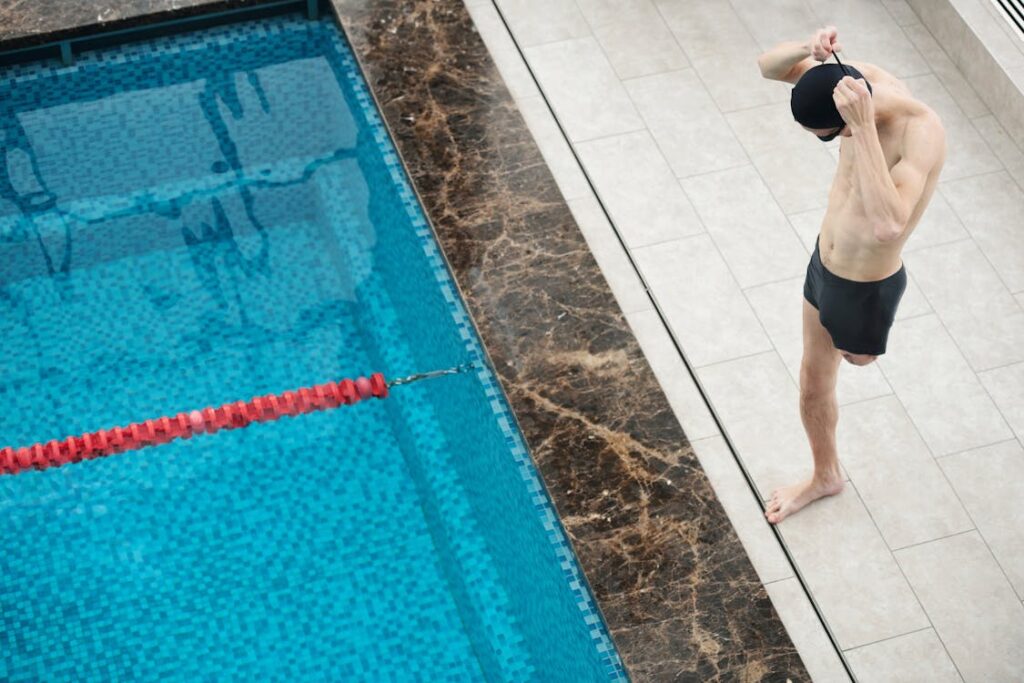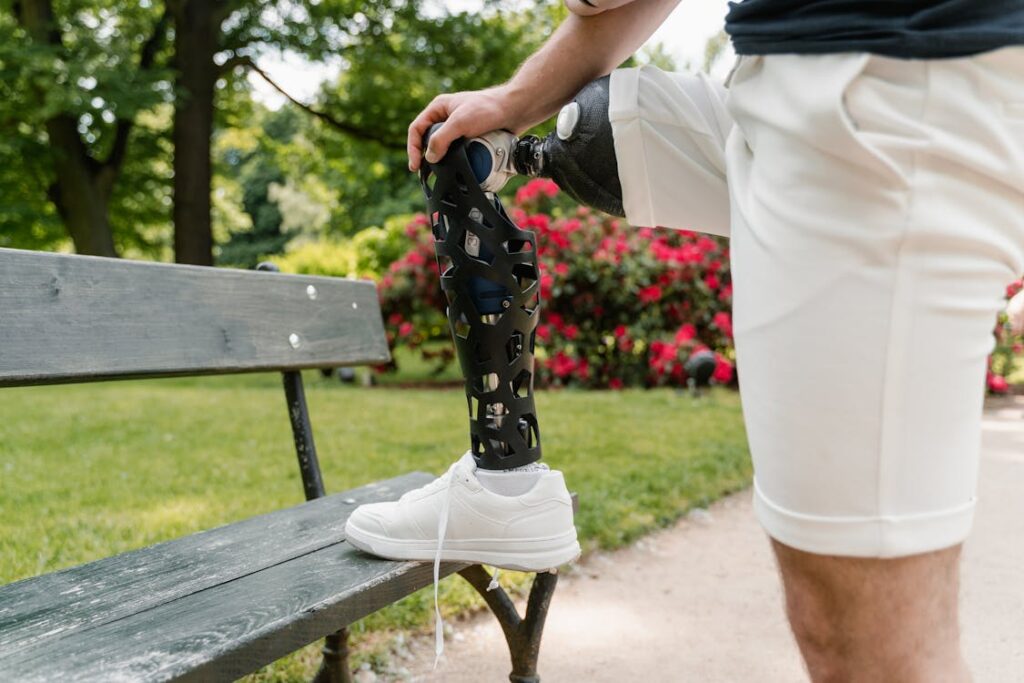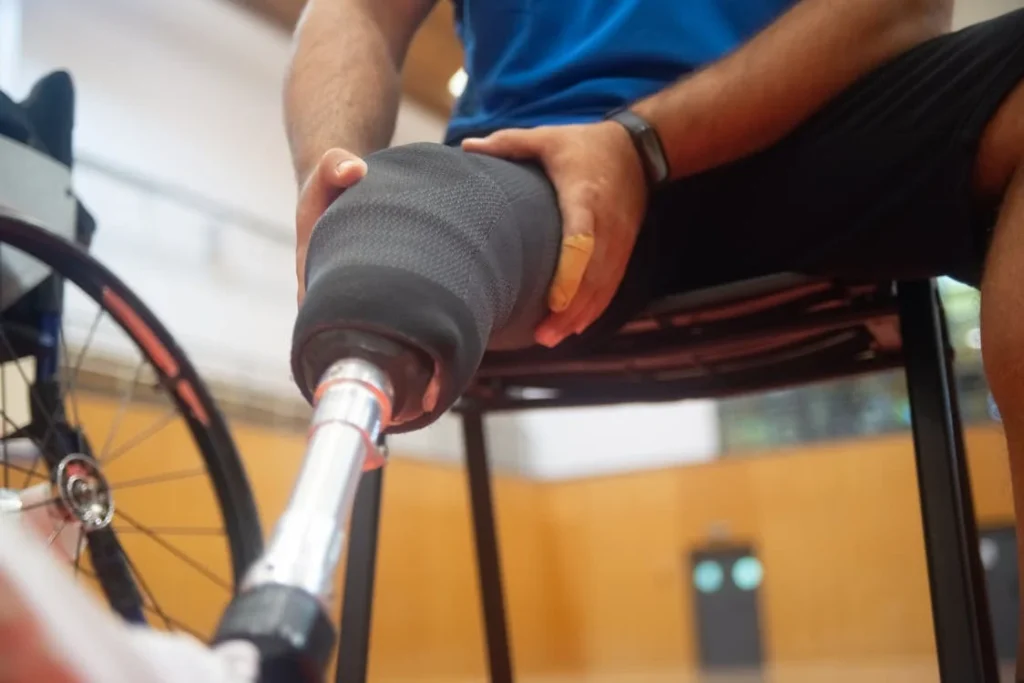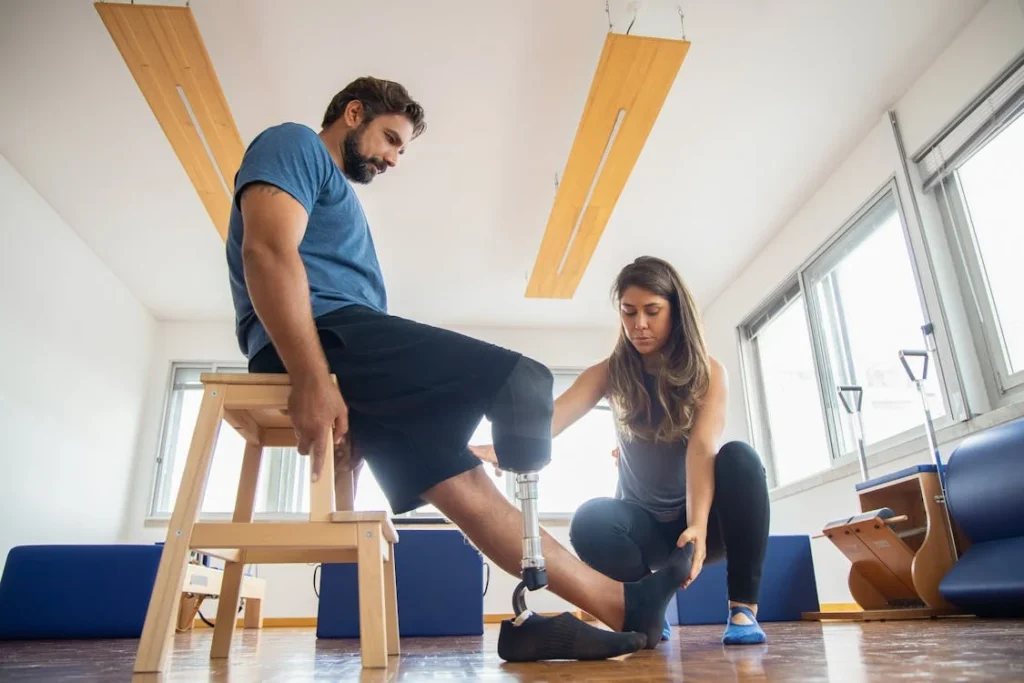Losing a limb can feel like the world has shifted beneath your feet. It’s not just about the physical change—it affects how you move, how you feel, and how you live every day. That’s why the journey to using a prosthetic doesn’t begin with the prosthetic itself. It starts much earlier, during pre-prosthetic therapy.
This phase is one of the most important parts of your recovery. It’s where your body and mind prepare for what comes next. It helps you heal, get stronger, and become ready to use a prosthetic limb comfortably and confidently. But here’s the catch—many people unknowingly make mistakes during this time. And these mistakes can delay healing, increase pain, or make the prosthetic harder to use later on.

Mistake 1: Rushing the Healing Process
Ignoring the Body’s Need for Rest
One of the most common mistakes during pre-prosthetic therapy is not allowing enough time for the body to heal after amputation. It’s natural to feel eager to “get back to normal” and start using a prosthesis.
Many patients feel the urge to push themselves, to speed up recovery and move on. But your body has just gone through a major surgery. It needs time to recover—not just on the surface but deep within the muscles, tissues, and nerves.
Trying to stand or walk before your residual limb is fully healed can lead to complications like wound reopening, infections, and swelling. These problems slow everything down. Instead of getting closer to your goals, you may find yourself back in the hospital or restarting therapy from scratch.
Taking it slow doesn’t mean giving up. It means giving your body the care it deserves. Follow your medical team’s advice closely, especially in the early weeks. If they say to rest, elevate your limb, or avoid putting pressure on it—listen. These small things can have a big impact later on.
Overdoing Early Exercises
Physical therapy starts very early in the recovery process, and that’s a good thing. But doing too much too soon can be just as harmful as doing too little.
Some patients think that pushing through pain will make them stronger. The truth is, pain is a signal. It tells you when something isn’t right.
If you overwork your limb before it’s ready, you may end up damaging soft tissues or creating long-term problems with mobility. Progress in pre-prosthetic therapy is not about intensity—it’s about consistency and proper technique. Simple movements, done the right way, will always beat aggressive ones done in pain.
It’s also important to trust your therapist. They’re trained to watch your movement and guide you through each phase of therapy. If they ask you to stop or adjust an exercise, it’s for a reason.
Mistake 2: Skipping Mental and Emotional Preparation
Overlooking Emotional Recovery
Amputation is not just a physical loss—it also takes an emotional toll. It’s completely normal to feel sadness, frustration, or even anger. But one of the biggest mistakes people make is pretending those feelings don’t exist.
Some patients believe they have to stay “strong” and push down their emotions. Others are afraid of being a burden to their families or caregivers. This silence can build up and lead to depression, anxiety, or withdrawal, all of which make the rehab process harder.
Pre-prosthetic therapy isn’t just about muscles—it’s also about mindset. Emotional readiness plays a huge role in how well you adapt to a prosthetic. If you’re overwhelmed or disconnected, it’s harder to follow through with therapy and learn how to use a new limb.
Talking to a counselor, joining a support group, or even just having honest conversations with loved ones can make a huge difference. Let yourself feel what you feel. You’re not weak—you’re human. Healing emotionally is just as important as healing physically.
Not Asking for Help
Sometimes, people think they have to go through this journey alone. Maybe they don’t want to worry their family. Or maybe they think they’re supposed to handle everything by themselves. But refusing help can make things harder than they need to be.
This is a time when support matters. Whether it’s a spouse, a friend, a physiotherapist, or another amputee—you need people around you. Asking for help is not a sign of weakness. It’s a smart, healthy part of recovery.
If you’re struggling to manage your daily routine, say so. If something feels confusing or scary, talk about it. Pre-prosthetic therapy becomes much more effective when you have a support system around you.
Mistake 3: Not Taking Care of the Residual Limb
Poor Hygiene Habits
During pre-prosthetic therapy, the health of your residual limb is everything. But many people don’t realize just how important daily care is. Not cleaning the limb properly or ignoring early signs of infection can lead to serious issues that delay prosthetic fitting.
After surgery, your limb is in a fragile state. It needs to be kept clean, dry, and protected. You should follow every hygiene step that your care team suggests.
This might include gently washing the area, checking for signs of redness or swelling, and using only approved ointments or dressings.
Sometimes, people try to use strong soaps or unapproved creams, thinking they’re being extra careful. But harsh chemicals can irritate the skin or affect healing. Keep it simple. Use only what your therapist or doctor tells you to use.
Not Managing Swelling
Swelling is a natural part of healing, but it needs to be managed. Uncontrolled swelling can change the shape of your limb, which makes it harder to get the right prosthetic fit later. It can also cause more pain and slow your progress.
To manage swelling, you might be asked to wear compression socks or use elastic bandages. Elevating the limb regularly helps too. But one of the most common mistakes is wearing compression wraps incorrectly.
If they’re too tight, they can cut off blood flow. If they’re too loose, they don’t help at all.
This is where training and practice come in. Your therapist should teach you how to wrap your limb properly and check that you’re doing it right. If something doesn’t feel right—numbness, tingling, or too much pressure—say something. Adjustments can always be made.
Mistake 4: Not Following a Consistent Therapy Routine
Skipping Sessions or Exercises
One of the easiest traps to fall into is inconsistency. Missing a session here and there might not seem like a big deal, but it adds up quickly.
Pre-prosthetic therapy is designed to help your body regain strength, improve balance, and get ready for a prosthetic limb. Skipping sessions can interrupt that progress and cause setbacks.
Even when you’re not in pain, skipping exercises slows down your muscle recovery. And when you are in pain, stopping completely can lead to stiffness and weakness.
There’s a balance to strike—doing enough without overdoing it. Your therapist will help you find that balance, but sticking to the routine is your part of the job.
Therapy works best when it becomes part of your daily rhythm. Just like brushing your teeth or eating a meal, exercises and limb care need to be a regular habit. Over time, they’ll feel less like a chore and more like second nature.
Thinking Therapy Ends at the Clinic
Another common mistake is thinking that therapy only happens during scheduled appointments. While your sessions with the physiotherapist are crucial, what you do at home matters just as much.
Many of the gains made in therapy are reinforced by home exercises. These might be small movements, stretches, or balance tasks, but they’re powerful. If you only move your body during clinic visits and stay inactive the rest of the time, your muscles won’t improve the way they should.
That’s why therapists often give a “home plan.” It’s more than homework—it’s a guide to building a stronger, more stable body. These daily exercises help you maintain flexibility, prevent contractures, and prepare your body to use a prosthesis more comfortably.

Mistake 5: Not Preparing the Residual Limb for the Prosthesis
Avoiding Desensitization Techniques
After amputation, the residual limb often becomes very sensitive to touch. Even the lightest fabric might feel uncomfortable. Some people think this will go away on its own, but it usually doesn’t. That’s why desensitization is such a key part of pre-prosthetic therapy.
Desensitization helps your limb adjust to different textures and pressures. This makes wearing a prosthetic socket more comfortable later. Skipping this step can make the first few weeks with a prosthetic much more difficult, sometimes even painful.
Therapists usually recommend using soft materials like cotton, tissue, or a soft towel to gently rub the limb. Over time, they’ll increase the intensity with items like textured fabrics or tapping techniques.
It’s a slow and steady process, but it works. If you skip it, your limb stays overly sensitive, and your brain continues to treat even normal touch as discomfort.
Being patient with this part of therapy can make a huge difference in how comfortable you feel with your prosthetic in the future.
Ignoring Scar Management
After surgery, the scar on your residual limb needs special attention. If you don’t take care of it, the scar can become tight, thick, or raised, which makes it hard for the prosthesis to fit correctly.
Sometimes, people think that once the skin has closed, the scar will take care of itself. But it doesn’t. Scar tissue behaves differently than regular skin. It can pull in certain directions or feel hard and stiff. If left untreated, it can even cause pain or limit your range of motion.
Massaging the scar gently, using lotion as recommended, and keeping the area clean and moisturized helps it stay soft and flexible. Your therapist may also teach you how to stretch the skin safely, which helps it move more freely as your body heals.

Mistake 6: Neglecting Balance and Core Strength
Forgetting the Rest of the Body
Pre-prosthetic therapy isn’t just about the limb that was amputated—it’s about your whole body. Many people focus only on their residual limb, forgetting that every movement starts from the core.
When your balance is off or your abdominal muscles are weak, it affects how you walk, stand, and sit.
If you ignore this part of therapy, you might find yourself limping, slouching, or putting too much strain on your back or other joints once you start using a prosthesis. Over time, these imbalances can lead to more injuries or even damage to your prosthetic.
Your therapist might include exercises that seem unrelated to your limb—like leg lifts, seated twists, or shoulder movements. These are not random. They’re designed to bring your body back into alignment and teach you how to move smoothly again.
Taking time to rebuild your core muscles and overall balance can also improve your confidence. When your body feels steady, your mind feels more in control.
Not Practicing Weight Shifting
After limb loss, your sense of balance changes completely. Your body has to re-learn how to move, stand, and shift weight without the limb that’s no longer there. Some people instinctively lean to one side or use crutches for too long, which can cause muscle imbalances.
Weight shifting exercises teach your body how to distribute pressure evenly. This is especially important before you start using a prosthetic leg. If your body doesn’t know how to handle weight properly, you’re more likely to stumble, fall, or overuse certain muscles.
Practicing simple movements like sitting and standing, stepping from side to side, or shifting weight from one leg to the other can train your muscles to respond naturally. Over time, these small steps prepare your body for bigger movements like walking with a prosthetic.
Mistake 7: Delaying Communication with the Rehab Team
Not Reporting Discomfort or Pain Early
One silent mistake that often causes bigger problems later is staying quiet when something doesn’t feel right. Some patients don’t want to bother their therapist or think that pain is just “part of the process.”
While some discomfort is normal, ongoing pain is a red flag. It’s not something to push through or ignore.
If your residual limb hurts in a new way, feels numb, or has unusual swelling, it’s important to report it right away. Even small issues like tingling or skin redness can be early signs of bigger complications. Addressing them early prevents delays and keeps your recovery on track.
Good communication with your therapist and doctor is a partnership. They rely on you to share your experiences, and you rely on them to guide your recovery safely. The sooner you speak up, the faster things can be corrected.
Withholding Information About Mental Health
Emotional stress doesn’t always show up as tears or sadness. It can look like silence, missed appointments, or lack of motivation. If you’re feeling down, overwhelmed, or disconnected, it’s essential to share that with your therapist or counselor.
There is no shame in feeling emotionally drained. The journey after amputation is life-changing, and emotional ups and downs are part of it. But many patients feel pressure to appear “fine,” which leads them to bottle up how they really feel.
Therapists are trained to support your whole well-being, not just your physical health. Telling them about your emotional state allows them to adjust your care plan and connect you with the right support—whether that’s a mental health professional, a support group, or stress-reducing exercises.
Mistake 8: Wearing the Wrong Clothes or Footwear
Dressing in a Way That Interferes with Therapy
What you wear during therapy sessions matters more than you might think. Clothes that are too tight or too loose can get in the way of movement.
Shoes that don’t offer proper support can throw off your balance. Sometimes, patients wear sandals, slippery socks, or dress shoes to therapy—often without realizing the risks.
During pre-prosthetic therapy, your body is adjusting to new ways of moving. You need shoes that provide stability, a flat sole, and a secure fit. Avoid heels or overly cushioned footwear that can shift your posture or lead to falls.
Clothing should be comfortable and allow your therapist to see and access your residual limb if needed. This helps them guide your exercises better and prevents any unnecessary friction or pressure.
If you’re unsure what to wear, ask your therapist during your first session. It’s a simple change that can make your therapy more effective.
Overlooking Environmental Hazards
At home, therapy often continues between sessions. But many people forget to prepare their space. Loose rugs, wet floors, cluttered pathways—these small things can turn into dangerous obstacles during balance or strength exercises.
You may be asked to practice walking with support, shifting weight, or using stairs. If the area isn’t safe or stable, the risk of falling increases. It’s important to set up a clean, well-lit, and clear space at home where you can move freely.
Make sure there’s something sturdy nearby for support if needed, like a heavy chair or a handrail. And always follow your therapist’s instructions for home safety.

Mistake 9: Underestimating the Value of Patience
Wanting Instant Progress
After surgery, it’s natural to want quick results. But the truth is, pre-prosthetic therapy is not a race. Your body is learning how to work in a new way. This process takes time. Progress may feel slow, and that can be frustrating.
Some people get discouraged when they don’t see improvements quickly. They compare themselves to others or feel like they’re not doing enough. But every body is different. What matters most is steady, consistent effort—not how fast you improve.
Therapists often remind patients that even small wins count. Being able to sit up straighter, move more freely, or sleep without discomfort—these are all signs that therapy is working. Progress isn’t always dramatic. It’s found in the little moments, the everyday tasks that start to feel a bit easier.
Trust the process. The road is long, but every step matters.
Setting Unrealistic Expectations
Another mistake is setting goals that are too high too soon. It’s great to be ambitious, but expecting to walk perfectly or return to intense physical activity within weeks can lead to disappointment.
Your therapist will help you set realistic, achievable goals that match your body’s pace. These goals act like stepping stones—small milestones that build confidence and keep you motivated.
Try to focus on what’s happening right now. Celebrate today’s progress, not just tomorrow’s hopes. Being kind to yourself, even when it’s hard, is a huge part of successful therapy.
Mistake 10: Not Preparing for the Next Phase
Forgetting to Learn About Prosthetic Options Early
While you’re in pre-prosthetic therapy, it’s a good idea to start learning about the different types of prosthetics available. Some people wait until the very end, only to feel overwhelmed by the choices and unsure of what fits their lifestyle.
Each prosthetic has different features, and the right one depends on your body, your goals, and your daily needs. Understanding what’s available helps you make better decisions and prepares you for what’s coming next.
You can start by asking your therapist or prosthetist simple questions. What types of prosthetics are available for your level of amputation? How do they differ? What does maintenance involve?
This early curiosity gives you more control over your journey and helps you feel more confident when the time comes to be fitted.
Not Knowing What to Expect After Fitment
The journey doesn’t end when you get your prosthetic. In fact, that’s when a new chapter begins. One mistake many people make is thinking that once the device is fitted, everything will go back to normal instantly. But using a prosthetic is a learning process in itself.
There will be a period of adjustment. Your body needs time to get used to the new limb. You might need more therapy, some tweaks in the fit, and continued guidance on how to move safely.
Preparing yourself mentally for that transition makes it easier. Instead of seeing the prosthetic as the “final fix,” see it as a powerful tool—one that you’ll learn to use better every day.
Mistake 11: Not Involving Family or Caregivers Early On
Going Through the Process Alone
A lot of individuals going through pre-prosthetic therapy try to handle everything on their own. This might come from a place of pride or simply a desire not to worry others.
While independence is important, early rehabilitation benefits a lot from support—especially from people you live with or rely on day-to-day.
Your family or close friends don’t need to understand every medical detail, but involving them early helps in two big ways. First, it gives them a better idea of how to support you.
Second, it gives you someone to lean on during the tough days. They can help remind you to stay consistent, help with exercises, or even just encourage you when your motivation dips.
It also helps caregivers and loved ones know how to create a home environment that supports your recovery. That means they’ll be better prepared for tasks like setting up safe walking paths, helping with daily activities, or spotting problems with your residual limb that you might not notice.
Not Educating Your Inner Circle
Pre-prosthetic therapy and limb loss can be confusing, not just for the person going through it, but also for those around them. Sometimes, frustration comes from misunderstandings—like when family members assume you’re “fine” because you look okay, or when they don’t realize why something hurts when it seems simple.
Teaching your family what you’re learning in therapy can go a long way. Let them know about your daily challenges and small wins. When people understand the process, they’re more patient, more helpful, and more emotionally supportive.
It turns your recovery from something lonely into something shared—and that makes the whole experience a little easier to carry.

Mistake 12: Avoiding Nutrition and Sleep
Ignoring the Role of Good Nutrition
People often focus so much on exercises and physical healing that they overlook the basics—like eating well. But what you put into your body has a direct effect on how fast and how well you heal.
Poor nutrition slows tissue repair, weakens the immune system, and drains your energy. On the other hand, eating balanced meals with plenty of protein, vitamins, and minerals helps your body build muscle, reduce inflammation, and fight infection.
This doesn’t mean you need a complicated diet plan. Just making sure you eat regular meals with fresh vegetables, fruits, protein like eggs or lentils, and enough water can go a long way.
If you’re unsure about what’s best for you after surgery, you can ask your doctor or even a dietitian for basic advice. What matters most is not skipping meals and avoiding foods that make you feel sluggish or bloated.
Underestimating the Importance of Sleep
Rest is when the body heals. It’s that simple. But stress, pain, and new routines can make it hard to sleep well. Some patients think it’s okay to get by on a few hours of rest, especially if they’re keeping up with therapy. But sleep is not optional—it’s essential.
Without good sleep, your muscles don’t recover properly. Your mind becomes less sharp. Your energy dips, and motivation fades. Over time, it can make even the most committed patient feel worn out and stuck.
If you’re having trouble sleeping, talk about it with your therapist or doctor. Sometimes, simple changes—like adjusting your evening routine or elevating your limb—can make a big difference.

Mistake 13: Waiting Too Long to Begin Pre-Prosthetic Therapy
Believing It’s Too Soon to Start
A big misunderstanding is that therapy should only begin once the wound has completely healed. While the exact timing depends on the surgeon’s instructions, pre-prosthetic therapy actually starts in the early stages of recovery. In some cases, it begins within days of surgery.
This early therapy is gentle. It focuses on small movements, breathing exercises, posture, and simple activities that improve blood flow and prevent stiffness. Waiting too long to start therapy can cause delays in healing, reduced muscle strength, and joint stiffness that’s harder to fix later.
The goal is to keep the rest of your body active while your limb heals. That way, when the time comes to get a prosthetic, your body is already strong and flexible enough to begin training.
Always follow your medical team’s advice about when to begin. But don’t assume that early rest means complete inactivity. Your therapists know how to guide you safely.
Missing the “Window” for Best Results
There’s a certain period after surgery when the body is most responsive to therapy. The muscles are still adaptable, and your movement patterns haven’t fully changed yet. If therapy starts too late, your body may have already developed bad habits or compensations.
For example, if you’ve been limping or leaning heavily to one side, your muscles start to get used to that pattern. Changing it later becomes harder. Starting therapy during the body’s “window of adaptability” helps build better movement habits from the start.
The earlier you begin—with professional guidance—the better your outcome usually is.
Mistake 14: Comparing Your Progress to Others
Judging Yourself by Someone Else’s Journey
No two recoveries are the same. Your healing, therapy routine, and emotional responses are shaped by your unique body, your injury, your surgery, and your life situation. Yet it’s common to compare your progress with another amputee and feel like you’re behind.
This kind of thinking can quickly become discouraging. You might feel like you’re not doing enough, even if you’re actually progressing just fine. You might try to force your body to do more than it’s ready for, which leads to setbacks.
It’s okay to be inspired by others—but don’t turn their journey into your measuring stick. Progress looks different for everyone. Some people regain balance quickly. Others need more time to manage pain or improve flexibility. What matters is moving forward at your own pace.
Celebrate your wins, no matter how small they seem. Walking an extra step, sleeping better, or feeling less anxious are all real progress.
Mistake 15: Thinking Prosthetic Training Will Fix Everything
Expecting the Prosthetic to Do All the Work
One of the most common misconceptions is that once you get your prosthetic, everything else will fall into place. The truth is, a prosthetic is only as good as the body and mind using it.
If the muscles are weak, the balance is off, or the residual limb isn’t ready, even the most advanced prosthetic will feel uncomfortable or hard to use.
The work done during pre-prosthetic therapy lays the foundation. It prepares your muscles to support the prosthesis. It teaches your body how to stay upright, stable, and responsive. Without this groundwork, people often find their prosthetic heavy, painful, or awkward.
It’s not magic. It’s teamwork between your body and the device. Pre-prosthetic therapy is where that teamwork begins.
Neglecting to Build Daily Routines Around the Prosthetic
Once a prosthetic becomes part of your life, it affects how you dress, move, rest, and even think. Pre-prosthetic therapy helps ease that transition by slowly introducing routines that match what life will be like post-fitment.
Some people skip this preparation and then feel overwhelmed later. They struggle to adapt to the new rhythm because their body—and daily habits—aren’t aligned yet. Practicing how to stand, sit, transfer weight, and move in ways that mimic life with a prosthetic makes a huge difference.
When you get to that stage, your body will already have the patterns and strength it needs. The prosthetic won’t feel foreign—it’ll feel like the next natural step.
Mistake 16: Being Afraid to Speak Up About Uncertainty
Staying Silent About Concerns
During pre-prosthetic therapy, it’s normal to have questions. Will I be able to walk again? Will my prosthetic fit well? Will the pain ever stop? These questions can feel heavy, and many people are afraid to ask them. They might not want to hear the answer, or they’re scared they’ll seem ungrateful or negative.
But keeping those worries bottled up creates a gap between you and your care team. Your therapist can’t help with something they don’t know about. And often, just speaking your fears out loud makes them feel smaller, more manageable.
No question is too small or silly. If it matters to you, it matters. Speak up about discomfort, confusion, or anything that doesn’t feel right. The people helping you want to guide you through every part of this journey—not just the physical part.
Not Discussing Future Goals
Some people don’t share their long-term goals because they assume they’re too far off or unrealistic. Whether it’s playing sports, returning to work, dancing, or traveling, it’s important to talk about the life you want after recovery.
These dreams help shape your therapy plan. If your therapist knows you want to return to a certain activity, they can guide your exercises in that direction. Without that insight, you may be doing general therapy when a more personalized approach would be better.
Sharing your goals gives your team a clear target to work toward with you. It also helps keep you motivated through the slower days.

Mistake 17: Failing to Address Phantom Limb Sensations Early
Ignoring the Signs of Phantom Limb Pain
Many amputees experience phantom limb sensations—the feeling that the missing limb is still there. Sometimes it’s a mild tingling, but it can also be intense pain, cramping, or burning. A common mistake is to ignore these sensations or hope they’ll disappear on their own.
In some cases, they do fade. But often, without early treatment, phantom pain becomes more intense and harder to manage. It can interfere with therapy, sleep, and daily comfort.
Pre-prosthetic therapy includes strategies to reduce or manage these sensations. Gentle massage, mirror therapy, and mental imagery exercises can help your brain adjust to the change. Your care team may also suggest medication or other treatments if needed.
The key is to bring it up early. You don’t have to suffer in silence. There are ways to ease the discomfort, but only if your team knows what you’re feeling.
Assuming Phantom Sensations Mean Something Is Wrong
Because phantom pain feels so real, some patients think it means something has gone wrong with their surgery or healing. This worry can cause unnecessary anxiety and keep people from progressing in therapy.
Understanding that phantom sensations are a normal part of the brain adjusting to limb loss can help ease that fear. It doesn’t mean you’re broken. It means your brain is still rewiring. Therapy supports that process. The more you understand what’s happening, the less scary it feels.
If anything ever feels unusual or intense, always talk to your care provider—but don’t assume the worst. With support, even challenging sensations can become more manageable.
Mistake 18: Letting Frustration Take Over
Losing Patience with Yourself
The journey after limb loss is filled with highs and lows. Some days you’ll feel strong and hopeful. Other days, everything might feel hard. That’s normal. But when frustration builds up without a way to release it, it can turn into anger or self-doubt.
Some people start to think they’re failing if progress slows down. They forget how far they’ve already come. Others get upset at themselves for needing help, or for struggling with things they think should be easy.
Being hard on yourself doesn’t speed things up—it slows everything down. It takes away your focus and drains your energy. When frustration comes, pause.
Breathe. Look back at what you’ve overcome already. Talk to someone who understands. Take a break if you need to, but don’t give up.
Healing takes time, and every step matters—even the tough ones.
Letting One Bad Day Turn Into a Bad Week
Everyone has off days. Maybe the pain is worse. Maybe the exercise didn’t go well. Maybe emotions hit hard out of nowhere. That’s okay. What matters is not letting one hard day take over the whole week.
It’s easy to feel like stopping when you’ve had a setback. But missing several days of therapy or falling out of your routine makes it harder to start again. One off day doesn’t undo your progress—but quitting for too long can.
Try to see tough days as part of the process. You’re allowed to rest, feel your emotions, and come back when you’re ready. Just don’t let that one moment stop all the momentum you’ve built.
Your future self will thank you for continuing—even if today feels hard.
Mistake 19: Not Staying Informed About What Comes Next
Not Learning About the Fitting and Training Process
Once your limb has healed and you’re cleared for prosthetic fitting, a new chapter begins. But one mistake many people make is walking into that phase with no idea of what to expect. This can create stress, confusion, or even fear.
Understanding the steps ahead gives you a sense of control. Fitting a prosthetic isn’t a one-time event. It involves several stages—molding, adjusting, trying, and retraining your body to move with it. Each fitting might bring small changes based on how your limb responds.
Being informed helps you ask the right questions. You’ll know that if something feels wrong, it can be adjusted. You’ll be prepared to give feedback, to learn how to clean and maintain your device, and to make sure the fit is as comfortable as possible.
If your rehab team offers educational resources or recommends a session on prosthetic training, take it. The more you know, the smoother the journey will feel.
Avoiding Long-Term Planning
It’s easy to think only about the next milestone—getting the prosthetic, learning to walk again, returning to work. But long-term success requires planning ahead. That means understanding maintenance needs, regular check-ins, possible socket replacements, and even future upgrades.
Your prosthetic needs may change over time, especially as your limb reshapes or your lifestyle evolves. Preparing for this reduces surprise and helps you stay proactive. If you expect wear and tear, you’ll catch issues before they become bigger problems.
Therapists and prosthetists can guide you on timelines, common wear points, and how to keep your prosthetic functioning at its best. Just like a car or any tool, regular care extends the life of your device and helps you move confidently for years to come.
Conclusion
Pre-prosthetic therapy is not just the first step on your prosthetic journey—it’s the foundation for everything that follows. When you avoid the mistakes we’ve explored in this article, you give yourself the best possible chance to heal fully, regain mobility, and live confidently with your prosthetic limb.
This journey is physical, emotional, and deeply personal. It’s not always easy, and it rarely goes exactly as planned. But every moment of effort you put into therapy builds strength—not just in your body, but in your spirit.
What makes the biggest difference isn’t the kind of prosthetic you’ll use or how fast you recover. It’s your willingness to stay committed, to ask for help, to be patient with your progress, and to trust the process.
You are not alone. Whether you’re just beginning therapy or supporting someone who is, there’s a whole community of experts, caregivers, and fellow amputees walking this road with you. Every small win matters. Every effort adds up. And with the right mindset and support, your recovery can become a story of strength, independence, and transformation.



